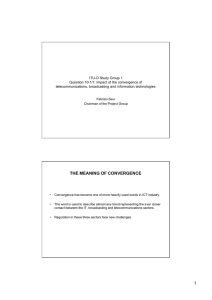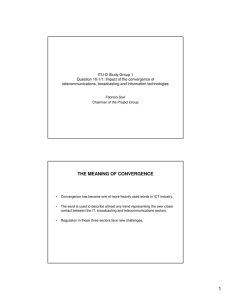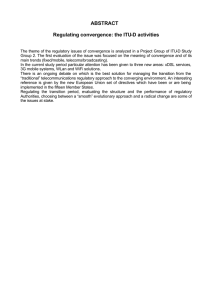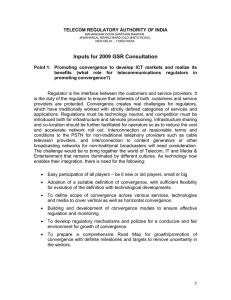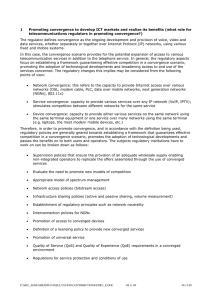ITU-D Study Group 1 Question 10-1/1: Impact of the convergence of
advertisement
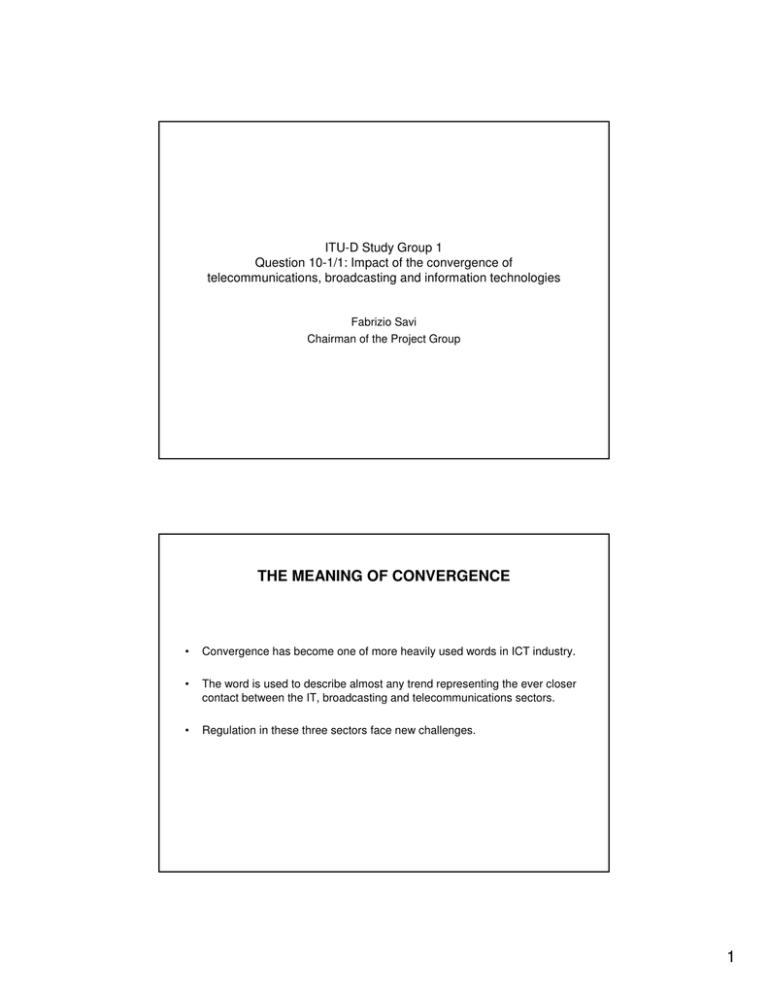
ITU-D Study Group 1 Question 10-1/1: Impact of the convergence of telecommunications, broadcasting and information technologies Fabrizio Savi Chairman of the Project Group THE MEANING OF CONVERGENCE • Convergence has become one of more heavily used words in ICT industry. • The word is used to describe almost any trend representing the ever closer contact between the IT, broadcasting and telecommunications sectors. • Regulation in these three sectors face new challenges. 1 Some questions and issues proposed for study in ITU • Is there general agreement to this evolutionary approach in the short term? • What will be the key regulatory issues in the digital future? • What regulatory approaches are likely to be appropriate? • How soon, and under what circumstances, will it be necessary to make fundamental changes to regulatory method and framework? • What are the implications for the regulatory framework? • How to manage the transition period? • What regulatory framework is most likely to be generally appropriate once services become substantially converged? • How to evaluate the performance of regulatory structures? Status of convergence policies by region (ITU source) Convergence Policy Countries 35 30 No policy no indication 25 No policy, no plans to adopt one No policy, but planned 20 15 10 Already exis ts 5 0 Africa Americas Arab States AsiaPacific Europe 2 Convergence legislation by region (ITU source) Convergence legislation Countries 40 35 30 No 25 Planned 20 15 Already exists 10 5 0 Africa Am ericas Arab States AsiaPacific Europe SOME ANSWERS AND OPTIONS 1/3 • The best regulatory solution seems to adapt the legislation to new services and move gradually towards a completely new regulatory framework • The European Union with its five directives has chosen the evolutionary approach • Concerning the Regulator the general orientation seems to be towards one converged regulator such as in the United Kingdom with the creation of OFCOM. There may be particular cases in federal states, where specific regulation competences are given to cantons or regional administrations but it is recommended to keep a coherent national regulatory policy 3 SOME ANSWERS AND OPTIONS 2/3 • The main regulatory trend is to move from sector specific ex-ante law towards ex-post application of competition law. It should be considered that convergence is leading to a new market, new to everyone. All competing operators should be allowed to operate under the same rules and so current asymmetries in regulation (i.e. specific obligations for operators with significant market power) should be gradually withdrawn, possibly with the introduction of “sunset clauses” • The convergence between traditional telecommunications, multimedia services and elements of information technology is already in place in almost all developed countries. The new regulatory model should be timely defined in order to be efficient. Even if converging services are not yet a reality in developing countries the recommended way of action is to proceed with a forward-looking approach to regulatory reforms SOME ANSWERS AND OPTIONS 3/3 • The privatization of incumbent, state owned operators is a political choice but if public ownership is maintained, a high level of transparency is required in the marketplace to be credible and become appealing for investors and competitors. Furthermore, transparency and credibility reduce the level of possible conflicts • The recommended target is light regulation with limited regulatory intervention. In the transition period strict control by the regulator may be needed in conjunction with the consultation with competition authorities • Regulation should be cost effective; so, the costs of regulation should not exceed the expected economic results and benefits to the competitive market. It is recommended to begin to study and establish mechanisms for the analysis and evaluation of the economic impact of regulation 4
